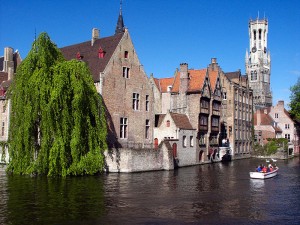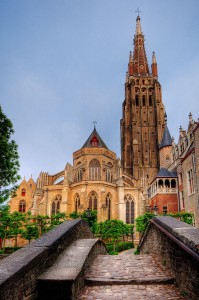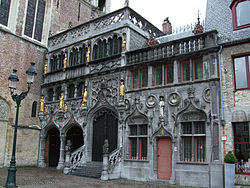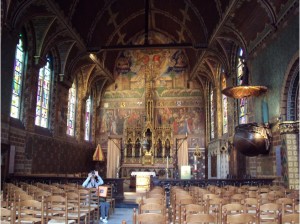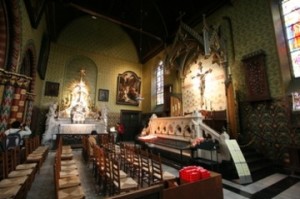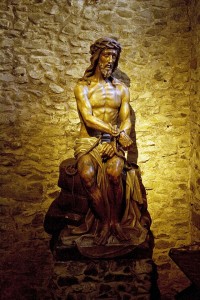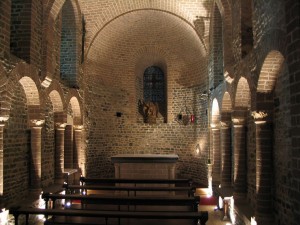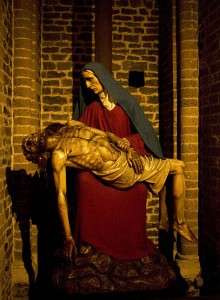Great are the works of the Lord, studied by all who delight in them. [Psalm 111:2, NRSV]
A Small Medieval City
Bruges is a real gem of a city.
In the center of Europe, but tucked away off the main highway of Belgium, almost as if nature is preserving this marvelously rich and beautiful testimony of human civilisation from the mad rush of the motorways, nestles the little medieval city of Bruges [“Brugge” in local Flemish].
[L] Bruges canal. [M] Church of Our Lady.
There is incredible, breath-taking beauty and culture, endless eateries and Belgian chocolate pralines shops. Even the June issue of Malaysia Airlines’ in-flight magazine spotlights the incredible tourist attractions this little riparian city holds for its visitors. Equally, and perhaps more important for us, this city combines its immense scenic beauty with a sheer, hidden-sort-of-way deep spirituality. Where in the world can you find such amazing combination?
We shall explore a little that unannounced deep spirituality.
A Basilica of Two Chapels
Tucked away in the back corner of Burg Square, nestles an inconspicuous and yet amazing building from the outside, but holds even more breath taking displays inside. This is the Chapel of the Holy Blood, also known as the Basilica of the Holy Blood (Basiliek van het Heilig Bloed).
This little basilica consists of two chapels, a Romanesque lower chapel and a Gothic upper chapel. It was first constructed in the 12th century and promoted to the rank of Basilica in 1923. The two chapels could not be more different: the Romanesque lower chapel is austere with very little decoration, while the Gothic upper chapel is resplendent with sumptuous colours and fine details.
The two chapels are connected by a big brick staircase, which runs behind the grand facade as we see in the photo above known as the ‘Steeghere’ facing the square. The stairs and facade were built in late-gothic and Renaissance style in the 16th century, but demolished during the French Revolution. They were rebuilt in the 19th century. The gilded statues represent Flemish counts.
Located at the end of a square, the Basilica of the Holy Blood appears somewhat dwarfed by other, far bigger and imposing buildings. Once inside, however, this very old and petite building comes into its own. It is very quiet and serene, and yet visitors spontaneously find themselves in awe by the history and spirituality they instinctively feel embedded in every one of the many paintings and artifacts that greet them everywhere they turn.
1. The Upper Chapel: The Chapel of the Holy Blood
One can enter the basilica on the first floor where the Holy Blood is kept.
At the top of the staircase, one immediately enters into a very atmospheric place of worship. Lit by light through the stained glass windows, coupled with a hint of incense, and the sight of a pulpit in the form of a terrestrial globe, one eases effortlessly towards reverence, just like in the Middle Ages. Augmenting the magnificent atmosphere of this section is an ornate High Altar behind which is a colourful fresco depicting the Trinity that covers the entire breadth of the wall and rises to the ceiling. The whole ornate architecture and display of art and artifacts succeed at once to generate in the visitors an emotional feeling that they are in a very holy and spiritual place.
[L] Exterior of the basilica on Burg Square. [Source Wikipedia]. [M & R] Chapel upstairs Chape comprising a magnificent section, and an inner section containing the reliquary © Holly Hayes.
Off the main Chapel is the Chapel of the Holy Blood which has an ornately carved marble Altar and a magnificent tabernacle made of silver which houses the relic of Christ. This is his very blood, believed to have been collected by Joseph of Arimathea. This basilica is actually famous on account of this holy relic. The Eucharist is celebrated in this side chapel daily. Participants also have a chance to view the relic after Mass. It is important to check the exact time schedules.
Concerning the Holy Blood, after all these years, the exact “historical records” are somewhat difficult to pinpoint. Three versions of the historical account, amongst presumably many others that are readily accessible from the internet, are appended below for ease of reference:
- Legend has it that after the Crucifixion, Joseph of Arimathea wiped blood from the body of Christ and preserved the cloth. The relic remained in the Holy Land until the Second Crusade, when the King of Jerusalem Baldwin III gave it to his brother-in-law, Count of Flanders Diederik van de Elzas. The count arrived with it in Bruges on April 7, 1150 and placed it in a chapel he had built on Burg Square.
- The first historical record to mention the Holy Blood in Bruges dates from 1256. The real story seems to be that it came from Constantinople, which had an extensive collection of relics including one of the Holy Blood. Constantinople was sacked by the Crusader army of Count of Flanders Baldwin IX in 1204, during the Fourth Crusade. Baldwin IX probably sent the Holy Blood, looted from the Byzantines, to Bruges shortly thereafter. The manner in which the rock-crystal vial is cut also suggests an origin in Constantinople.
- According to recent investigations, the bottle of rock crystal, containing the blood, dates back to the 11th or 12th century. Since its arrival in Bruges it has never been opened. It is almost certain that the bottle was made in the area of Constantinople (now Istanbul in Turkey) and that it was meant to contain perfume. The Bible never mentioned the fact that Christ’s blood was preserved. One of the apocryphal gospels mentions that Joseph of Arimathea preserved the blood after he had washed the dead body of Jesus. Tradition has it that count ‘Diederik van den Elzas’ brought the relic containing the blood of Christ from Jerusalem to Bruges after the second crusade. Recent investigations, however, prove that the relic arrived later in Bruges, probably around 1250 and that it came from Constantinople.
The Holy Blood relic is embedded in a rock-crystal vial, which is placed inside a small glass cylinder capped with a golden crown at each end. The relic is kept in a magnificent silver tabernacle with a sculpture of the Lamb of God in a side chapel of this upper level chapel. Messages of gratitude for prayers answered cover the back wall.
An internationally famous and colorful ‘Procession of the Holy Blood’ is held on Ascension Day in the spring through the streets of Bruges. During the procession, local citizens dressed in historical costumes enact biblical scenes and re-enact the arrival of the Count of Flanders who brings the holy relic to Bruges, as they accompany the bishop of Bruges carrying the relic. The tradition of the procession is first recorded in 1291.
The city itself, or the upper chapel of the Basilica, is sufficient to warrant a special trip to Bruges. But there is more. For us, it is the lower chapel of the Basilica that turns this small medieval city of exquisite beauty into a worthy city of quiet spiritual retreat.
2. The Lower Chapel: The Basilius Chapel
The lower chapel is called the Basilius chapel, the Chapel of St Basil, the only Romanesque church in West Flanders, dating from the first half of the 12th century. It was built by Derrick, Count of Alsace (1128-1168) and dedicated to St Basil the Great to house a relic of the Greek theologian (d.379) brought back from Caesarea during the Crusades.
Somewhat crammed for space, the entrance is as narrow as it is awkward, requiring a squeezy right turn even at the entrance. The chapel has a short nave, tiny side aisles, a choir and apse. Along the right aisle sits a polychrome statue (c.1306) of the Madonna and Child, displayed behind glass.
Stepping into the lower chapel, one immediately senses a special atmosphere and experiences sharp contrasts to the upper chapel.
While the upper chapel is colourful, bright and spacious, the lower chapel is plain, poorly lit and small. While every inch of the upper chapel is somehow embellished, the lower chapel is deliberately left in bare bricks and stones. And yet, the moment you walk into this lower chapel, you cannot help but be moved by its peace and serenity. There is something seriously moving and spiritual about its simplicity, colour dullness, and the non-clatter of just a few spot-lighted statues. It is a plain, simple and pious place. But truly, this chapel is seriously powerful. The Spirit of God has endowed this place with a heavy yet unobtrusive Presence. On any group of visitors of any persuasion and at any level of spirituality, you can sense its palpable effect.
Before three of these statues, one can sit for hours on silent meditation in that naturally prayerful ambience.
First, straight ahead of the entrance is an annex, in which sits a lifelike wooden statue of Christ, hands bound and head crowned with thorns. It is breathtakingly striking as you enter. Visitors are immediately drawn by the statue and instinctively need to sit and pray. It is very moving. Pilgrims spontaneously turn quiet and solemn as they recall the time of Jesus’ arrest at Gethsemane and the setting into motion of the train of unending torture in the passion narrative.
Second, at the end of the central nave is a small semi circular apse. In the apse window is a bronze statue of the pelican, a symbol for Christ in the Eucharist. By the time we reached this statue, many pilgrims were in tears as they sat meditating on the sacrificial love personified in Jesus.
Third, at the top of the left hand nave is a very emotive statue of the Pieta, with tears running down Mary’s cheeks. Pilgrims, watching the lifelike Christ, and resonating with Mary’s agony, kneel before this statue, reluctant to pull away. Among the pilgrims, we saw not a single dry eye.
The chapel on the ground floor has [L]Christ Arrested, sitting with thorn crown, [M]the main altar with Pelican, and [R] a very moving close-up view of the Pieta.
The statues of the Christ Arrested and the Pieta are paraded through the streets during the Procession of the Holy Blood, in May every year. While it is the very ornate and colourful upper chapel that attracts the most visitors, for us it is the undecorated lower chapel that really pulls us into deep spiritual reflection. There are no church officers around calling for silence. For here, somehow, reverence is the default option. It is truly amazing. Here, strangely, you involuntarily turn sombre, as images of the hostility experienced by Christ and the sacrifices he put up for the sake of humanity quietly work their way inside you, inviting you to shed tears for the sins of the world and of your own. So, like many other pilgrims, you may experience a strange mix of bliss and sorrow, even wanting to cry, but you will certainly find such an incredible gift of peace, and an irresistible force that draws you inexorably to Christ and His Mother, Mary.
Copyright © Dr. Jeffrey & Angie Goh, February 2016. All rights reserved.The chapel on the ground floor
You are most welcome to respond to this post. Email your comments to jeffangiegoh@gmail.com. You can also be dialogue partners in this Ephphatha Coffee-Corner Ministry by sending us questions for discussion.


